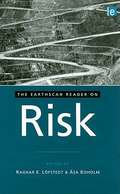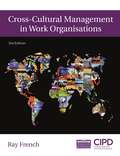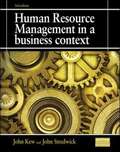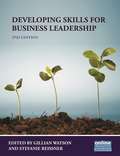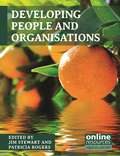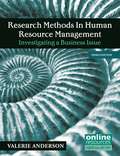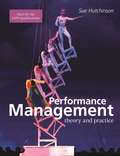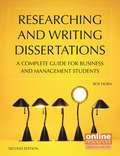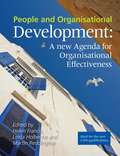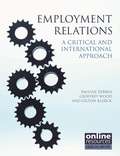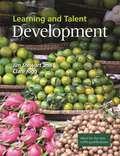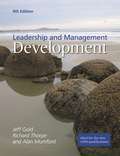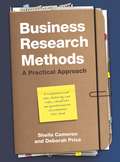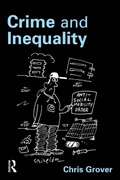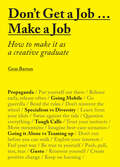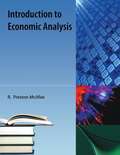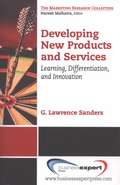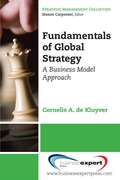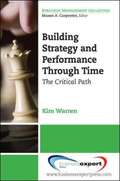- Table View
- List View
The Art Of Being A Brilliant Primary Teacher (PDF)
by Andy Cope Stuart SpendlowOn a good day, being a primary school teacher is the best job in the world. However, in the interests of grounding The Art of Being a Brilliant Primary Teacher in pure realism, Andy Cope and Stuart Spendlow readily acknowledge that it can also be the worst. The purpose of this book is to help you have more amazing days by inspiring and challenging you to be the best version of you because, at your best, you're flippin' awesome! Andy and Stuart use their experience, studies and 'what if?' moments combined with their 'don't judge us' attempt at humour to bring you a fun, slightly provocative, thoughtful and motivational read. This book isn't riddled with lectures and theories from old professors of centuries ago. It while it may be true that teaching was easier in the 'good old days' we reckon those days are long gone so our focus is on the here and now of teaching. These new days require some refined thinking and this book is simply designed to help you to be a brilliant primary school teacher whatever the weather (including wet playtime). Embrace the power of positive psychology, lift your happiness levels, discover tips and tricks to enhance your practice and get ready for some seriously brilliant primary teaching with this innovative, practical and positive guide. Andy and Stuart tell it like it is, without preaching. This is their light--hearted, thought--provoking take on modern primary teaching. For all primary teachers - from newly qualified teachers to senior leadership team members - who want to become, quite simply, brilliant.
Oil and Gas Law: Current Practice and Emerging Trends (2nd edition) (PDF)
by Greg Gordon John Paterson Emre ÜsenmezThe United Kingdom Continental Shelf is now routinely described as mature. It is no longer a new frontier of oil and gas exploration, with the steep climb up the production profile ahead of it and the principal question being how high that profile will rise. Rather, it is an established hydrocarbon province on the downward slope of the production profile, with the main question being how steep that decline will be.Insofar as this is the case, a new book on the subject of the law affecting oil and gas operations on the UKCS may appear to be rather late in joining the game. On the contrary, however, it is the very fact that the UKCS is now a mature province that provides the rationale for this book: maturity brings with it new problems and challenges and can present existing problems and challenges in a new light.But maturity also has a much more positive aspect: the accumulation of years also brings with it the accumulation of experience. Industry and government (and their respective lawyers) have learned a great deal in the 40 or so years of hydrocarbon operations on the UKCS. Mistakes have been made along the way and lessons have sometimes been learned the hard way. But the legal and regulatory framework that is now in place on the UKCS an justifiably claim to be one of the most advanced anywhere in the world.This book brings together academic and practising lawyers, all based in Aberdeen, Europe's Energy Capital, to consider the key regulatory and contractual dimensions of the mature hydrocarbon province.Editors:Greg Gordon, Lecturer in Law, University of AberdeenJohn Paterson, Reader in Law, University of AberdeenEmre U?enmez, Lecturer in Law, University of AberdeenTable of Contents:Introduction and Context1. Oil and Gas Law on the UK Continental Shelf: Current Practice and Emerging Trends2. Evolving Economic Issues in the Maturing UKCS3. The UK's Energy SecurityLicensing and Regulation4. Petroleum Licensing5. Mature Province Initiatives6. The UKCS Fiscal Regime7. Access to Infrastructure8. Health and Safety at Work Offshore9. Environmental Law and Regulation on the UKCS10. Decommissioning of Offshore Oil and Gas Installations11. Competition Law and the Upstream Oil and Gas BusinessContracting and Commercial Issues12. Joint Operating Agreements13. Unitisation14. Risk Allocation in Oil and Gas Contracts15. Law and Technology in the Oilfield16. Acquisitions and Disposals of Upstream Oil and Gas Interests17. Aspects of Land Law Relative to the Transportation of Oil and Gas in Scotland18. Dispute Management and Resolution[DUP logo]Cover design: Various Creative This highly successful book brings together academic and practising lawyers to consider the key regulatory and contractual dimensions of the mature hydrocarbon province. Now in its second edition, the text has been fully updated. New chapters look at Energy Security, Law and Technology in the Oil Field and Acquisitions and Disposals.
Earthscan Reader Series: The Earthscan Reader on Risk (PDF)
by Ragnar LofstedtThis new anthology is a comprehensive introduction to the field of risk theory. The introduction provides the ideal starting point for students and professionals new to risk studies and offers a concise refresher for researchers and practitioners. Coverage includes the origins of the 'concept of risk' and its often misunderstood cousin 'uncertainty,' before moving on to address risk perception, risk communication, the idea of trust and post trust as well as risk in policy and regulation with a close look at the Precautionary Principle. Following the introduction, the volume includes a selection of the most significant and influential works on risk in their entirety. These selections, organized thematically to cover the breadth and depth of the field, provide greater detail and elaborate on the key themes and major developments in risk studies. Together they comprise the essential literature necessary for a full understanding of risk theory and practice on any issue and in any context.
Cross-Cultural Management in Work Organisations
by Ray FrenchCross-Cultural Management is the essential introduction to cross-cultural social relations in the work setting. Alternate ISBNS 9781843981497 9781843982432
Human Resource Management in a Business Context
by John Kew John StredwickThis textbook has been written for the new CIPD postgraduate module on human resource management in context. It has been written for students with little or no prior knowledge of the subject area.
Developing Skills for Business Leadership
by Gillian Watson Stefanie ReissnerWritten for the CIPD module, Developing Skills for Business Leadership, this text is also ideal for postgraduate business students taking a module in professional development, career development or management skills.
Developing People and Organisations
by Patricia Rogers Jim StewartOne of three books developed to cover the entire intermediate level CIPD qualification. This title focuses on optional HRM units. The other titles consist of Studying Human Resource Management and Managing People and Organisations.
Research Methods in Human Resource Management: Investigating a Business Issue
by Anderson Valerie Dr Anderson ValerieClear and easy to follow, Anderson's latest edition guides you through the planning and execution of HRM research projects, at any level.
Performance Management: Theory and Practice
by Sue Hutchinson'Performance Management' is an essential core text for any student taking a performance management module at undergraduate or postgraduate level.
Researching and Writing Dissertations
by Roy HornStudents often struggle when faced with the task of researching and writing a dissertation. This text is an easy-to-use and concise guide to the entire process, from basic research methods to writing that will be invaluable for anyone completing a business dissertation or management report.
International Human Resource Management: A Cross-Cultural and Comparative Approach
by Crystal Zhang Paul IlesInternational Human Resource Management offers coverage of international, comparative and cross-cultural HRM. Ideal for students taking this subject for the first time or studying in their second language, this title balances theory with cases and examples from across the globe.
People and Organisational Development: A new Agenda for Organisational Effectiveness
by Linda Holbeche Helen Francis Martin ReddingtonThe authors bring to People and Organisational Development the benefit of both academic and practitioner experience.
Employment Relations: A Critical and International Approach
by Pauline Dibben Gilton Klerck Geoffrey WoodThis text takes an integrated international approach and perspective and is designed to map on to the revised CIPD module. It takes a critical approach for those wanting to engage in critical debates, combined with an academic approach, drawing on the latest research.
Learning and Talent Development
by Jim Stewart Clare RiggThis textbook has been written for the new CIPD postgraduate module Learning and Talent Development.
Leadership and Management Development
by Jeffrey Gold Richard ThorpeFirmly established as the leading text in its field, Leadership and Management Development is the ideal core text for students on the CIPD PDS qualification and on business and HR degree programmes, both at undergraduate and postgraduate level.
Business Research Methods: A Practical Approach
by Sheila Cameron Deborah PriceDespite the existence of very strong research methods textbooks, students still struggle with undertaking a research project. The quality of their research is often poor, research questions are badly thought out and their final work can be poorly written. Cameron and Price believe that this is because students struggle to relate the content in research methods textbooks to their own situations.
Crime and Inequality
by Chris GroverThis book examines key relationships between material circumstances and crime, and analyzes the areas of social policy - in particular social security and labour market policy - that are most important in terms of dealing with inequality at the lower end of the income hierarchy. It seeks to explain why inequality is linked to offending behaviour and the evidence underpinning explanations for this, and looks in detail at the relationship between offending and anti-social behaviour and its management through social policy interventions. Crime and Inequality draws upon both criminological and social policy approaches to understand this vital relationship, moving beyond criminological approaches which often fail to analyse the way the state attempts to manage poor material circumstance, offending and anti-social behaviour through social policy. The main aims of the book are threefold: to draw upon the disciplines of both criminology and social policy to understand the relationship between crime and inequality; to provide an in-depth analysis of those aspects of social policy that have a bearing on the context, management and punishment of offending behaviour; to examine government crime and anti-social behaviour policies in the context of social security and labour market policies, and to identify the tensions that have resulted from attempts to address social justice issues while also making individuals responsible for their actions. Alternate ISBN 9781843923305
Take Control Of The Noisy Class: From Chaos To Calm In 15 Seconds (PDF)
by Rob PlevinDo you struggle to get students to listen in your lessons? Do you find students dragging their heels to your lessons only to battle with you from bell to bell? Are you fed up with students who talk over you and ignore your instructions? Are you tired, drained and worn out because of low level disruption, disobedience and defiance? Do you long for a workable, practical system to help you take control and enjoy stress--free teaching? If you answered 'yes' to any of those questions you'll love the highly effective, proven strategies in Take Control of the Noisy Class! Teacher--trainer Rob Plevin explains a clear, step--by--step plan for successfully managing the most challenging individuals and groups in today's toughest classrooms. Written in a friendly and accessible style, and packed with powerful, fast--acting techniques -- including a novel tactic to get any class quiet in 15 seconds or less -- this book helps teachers transform their ability to connect and succeed with hard--to--reach, reluctant learners. Even if you have never had 'the class from hell', you'll find hundreds of practical, useable ideas and interventions to meet students' needs and create a thoroughly enjoyable classroom climate for all concerned. Take Control of the Noisy Class! provides teachers with a proven system for dealing with disruptive, inappropriate behaviour in the classroom, enabling them to create calm, positive learning environments and trusting bonds with hard--to--reach students. Discover: effective behaviour management strategies, the power of routines, instructions and consequences, the importance of relationships, tips and tricks for tackling misbehaviour, proven techniques for getting a rowdy class's attention, strategies for maintaining lesson flow and a positive learning environment and effective classroom management strategies which curb misbehaviour and prevent it reaching the stage of involving the senior leadership team and school behaviour policy. Super--effective classroom management strategies for today's toughest classrooms. Relevant to teachers of all subjects and age groups - across primary and secondary schools. Ideal for individual teachers and leaders or as the basis of whole--school.
Don't Get a Job...Make a Job: How to make it as a creative graduate
by Gem BartonToo often a design or architecture degree is seen as a means to an end (a job in an established practice). But imagine for one moment that there are no employers, no firms to send your CV to, no interviews to be had – what would you do? How would you forge your own path after graduation?The current economic climate has seen many graduates chasing a finite number of positions. The most ingenious and driven designers have found weird and wonderful ways of making opportunities for themselves, often by applying their skills across the creative disciplines of art, design, architecture and interiors. Knowing what you want from your design career and being able to adapt your strategy to suit is basic and vital – just like in the wild, designers need to evolve.The book celebrates the various strategies that students and graduates are taking to gain exposure, while also including interviews and inspirational advice from those who are now enjoying success as a result of their creative approach to employment.
Walker and Walker: The Law of Evidence in Scotland (4th edition) (PDF)
by Margaret Ross James ChalmersWalker and Walker: The Law of Evidence in Scotland gives a comprehensive and detailed examination of the law of evidence in the broadest of civil and criminal contexts. The emphasis is upon rigorous examination of the issues affecting all who work with the law of evidence whether in court, chamber practice or legal education. This classic text has been updated throughout and due attention is given to changes in the context of legal proceedings, to changes in the nature of the evidence available to parties, and to the direct impact of the European Convention on Human Rights. Full account is also taken of the Criminal Justice (Scotland) Bill. Previous print edition ISBN: 9781845921651
Introduction to Economic Analysis
by R. Preston Mcafee Tracy R. LewisThis book presents standard intermediate microeconomics material and some material that, in the authors' view, ought to be standard but is not. Introductory economics material is integrated. Standard mathematical tools, including calculus, are used throughout. The book easily serves as an intermediate microeconomics text, and can be used for a relatively sophisticated undergraduate who has not taken a basic university course in economics. The focus of this book is on the conceptual tools and not on fluff. As such, it reflects the approach actually adopted by the majority of economists for understanding economic activity. There are lots of models and equations, and no pictures of economists ;-) Economic analysis is used in many situations. When British Petroleum sets the price for Alaskan crude oil, it uses an estimated demand model, both for gasoline consumers and also for the refineries to which BP sells. Economic analysis was used by experts in the antitrust suit brought by the U.S. Department of Justice both to understand Microsoft s incentive to foreclose (eliminate from the market) rival Netscape and consumer behavior in the face of alleged foreclosure. Stock market analysts use economic models to forecast the profits of companies to predict the price of their stocks. When the government forecasts the budget deficit or considers a change in environmental regulations, it uses economic models. This book presents the building blocks of the models in common use by an army of economists thousands of times per day. This book, plus econometrics, provides most of the economic analysis tools to take upper division economics courses of any type.
Introduction to Economic Analysis
by R. Preston Mcafee Tracy R. LewisThis book presents standard intermediate microeconomics material and some material that, in the authors' view, ought to be standard but is not. Introductory economics material is integrated. Standard mathematical tools, including calculus, are used throughout. The book easily serves as an intermediate microeconomics text, and can be used for a relatively sophisticated undergraduate who has not taken a basic university course in economics. The focus of this book is on the conceptual tools and not on fluff. As such, it reflects the approach actually adopted by the majority of economists for understanding economic activity. There are lots of models and equations, and no pictures of economists ;-) Economic analysis is used in many situations. When British Petroleum sets the price for Alaskan crude oil, it uses an estimated demand model, both for gasoline consumers and also for the refineries to which BP sells. Economic analysis was used by experts in the antitrust suit brought by the U.S. Department of Justice both to understand Microsoft s incentive to foreclose (eliminate from the market) rival Netscape and consumer behavior in the face of alleged foreclosure. Stock market analysts use economic models to forecast the profits of companies to predict the price of their stocks. When the government forecasts the budget deficit or considers a change in environmental regulations, it uses economic models. This book presents the building blocks of the models in common use by an army of economists thousands of times per day. This book, plus econometrics, provides most of the economic analysis tools to take upper division economics courses of any type.
Developing New Products and Services
by G. Lawrence SandersThe focus of the book is on the up-front activities and ideas for new product and service development. A central theme of this book is that there is, or should be, a constant struggle going on in every organization, business, and system between delivering feature-rich versions of products and services using extravagant engineering and delivering low-cost versions of products and services using frugal engineering. Delivering innovative products is accomplished by an endless cycle of business planning, creative and innovative insight, and learning-about and learning-by-doing activities. A number of powerful concepts and tools are presented in the book to facilitate new product development. For example, three templates are presented that facilitate new product and service development. The FAD (features, attributes, and design) template is used to identify the features and attributes that can be used for product and service differentiation. The Ten-Ten planning process contains two templates: an Organizational and Industry Analysis template and the Business Plan Overview template. These two templates coupled with the FAD template can be used to develop a full-blown business plan. Entrepreneurship, technology and product life cycles, product and service versioning, product line optimization, creativity, lock-in real options, business valuation, and project management topics are also covered.
Fundamentals of Global Strategy
by Cornelis A. de KluyverThis book looks at the opportunities and risks associated with staking out a global competitive presence and introduces the fundamentals of global strategic thinking. We define crafting a global strategy in terms of change: how a company should change and adapt its core (domestic) business model to achieve a competitive advantage as it expands globally. The conceptual framework behind this definition has three fundamental building blocks: a company's core business model, the various strategic decisions a company needs to make as it globalizes its operations, and a range of globalization strategies for creating a global competitive advantage. A business model is defined in terms of four principal components: (a) market participation--who its customers are, how it reaches them and relates to them; (b) the value proposition--what a company offers its customers; (c) the supply chain infrastructure--with what resources, activities and partners it creates its offerings; and finally, (d) its management model--how it organizes and coordinates its operations. Globalization requires a company to make strategic decisions about each component of the business model. Market participation decisions include choosing which specific markets or segments to serve, domestically or abroad; what methods of distribution to use to reach target customers; and how to promote and advertise the value proposition. Globalization decisions about the value proposition touch the full range of tangible and intangible benefits a company provides to its customers (stakeholders). Decisions about a company's value chain infrastructure deal with such questions as, What key internal resources and capabilities has the company created to support the chosen value proposition and target markets? What partner network has it assembled to support the business model? How are these activities organized into an overall, coherent value creation and delivery model? Finally, strategic decisions about the global management dimension are concerned with a company's choices about a suitable global organizational structure and decision-making process. We use Pankaj Ghemawat's well-known "AAA Triangle" framework to define three generic approaches to global value creation. Adaptation strategies seek to increase revenues and market share by tailoring one or more components of a company's business model to suit local requirements or preferences. Aggregation strategies focus on achieving economies of scale or scope by creating regional or global efficiencies; they typically involve standardizing a significant portion of the value proposition and grouping together development and production processes. Arbitrage is about exploiting economic or other differences between national or regional markets, usually by locating separate parts of the supply chain in different places.
Building Strategy and Performance
by Kim WarrenThe fundamental challenge facing business leaders is to drive performance into the future--the dynamics of strategy. To tackle this effectively, they need a clear understanding of what causes performance to improve or deteriorate and what power they have to change this trajectory for the better. Without this understanding, they risk making poor choices about their future--failing to exploit promising opportunities, pursuing unachievable aims, or falling victim to competitive and other threats. Building Strategy and Performance Through Time sets the agenda for building business strategy in powerful, actionable, and accessible terms. It gives executives clear frameworks for answering three fundamental questions: * Why is our business performance following its current path? * Where is it going if we carry on as we are? * How can we design a robust strategy to transform this future? The existing strategy tools most widely used help guide management's choices about where to compete--which customers to serve, with what products and services, and how to deliver those products and services to those customers effectively and profitably. While this choice is important, it is not often changed in any fundamental way; having found a reasonably strong and profitable position on these issues, few firms will, or should, set off in a new direction. But there is still much to be done to deliver that strategy, powerfully and sustainably over time. Many decisions need to be made, continually and holistically, across all functions of the business and adapted as conditions change from month to month and year to year. Pricing, product development, marketing, hiring, service levels, and other decisions cannot be made in isolation but must take into account other choices being made, elsewhere and at different times. Building Strategy and Performance Through Time explains a reliable, practical method, known as strategy dynamics, that creates a living picture of how an enterprise actually works and delivers performance. This picture shows exactly where the levers are that management controls and how to choose what to do, when, and how much, to accomplish your specific goals. It shows, too, how the same approach can be used to defeat competitors, cope with other outside forces, and keep delivering performance.


